Research Progress and Hotspot Analysis of Urban Heat Island Effects Based on Cite Space Analysis
Abstract
1. Introduction
2. Materials and Methods
2.1. Database and Screening
2.2. Analytical Methods
3. Results
3.1. Annual Distribution
3.2. Journal Distribution and Subject Categories
3.3. Cooperation Networks
3.4. Frequently Cited Literature
3.5. Time Zone Distribution of Keywords
3.6. Keyword Co-Occurrence and Emergent Analysis
3.7. Research Frontier of Key Issues
3.7.1. Influencing Factors of Urban Heat Islands
3.7.2. Urban Heat Island Mitigation Measures
3.7.3. Urban Heat Island Research Methods
4. Discussion
5. Conclusions
Author Contributions
Funding
Data Availability Statement
Conflicts of Interest
References
- Chen, L.; Jing, Y.; Sun, R. Urban eco-security pattern construction:targets, principles and basic framework. Acta Ecol. Sin. 2018, 38, 4101–4108. [Google Scholar] [CrossRef]
- Wu, Y.; Shan, Y.; Lai, Y.; Zhou, S. Method of calculating land surface temperatures based on the low-altitude UAV thermal infrared remote sensing data and the near-ground meteorological data. Sustain. Cities Soc. 2022, 78, 103615. [Google Scholar] [CrossRef]
- Xin, J.; Yang, J.; Wang, L.-E.; Jin, C.; Xiao, X.; Xia, J. Seasonal differences in the dominant factors of surface urban heat islands along the urban-rural gradient. Front. Environ. Sci. 2022, 10, 1681. [Google Scholar] [CrossRef]
- Howard, L. Climate of London Deduced from Metrological Observations, 3rd ed.; Harvey and Darton Press: London, UK, 1833; Volume 1. [Google Scholar]
- Yuan, R.; Huang, F.; Tang, S. Review of urban heat island effect. Territ. Nat. Resour. Study 2019, 1, 11–12. [Google Scholar] [CrossRef]
- Pan, Y.; Cui, L.-l.; Liu, C.; Chen, L.; Zhang, L. Spatiotemporal distribution of urban heat island effect based on MODIS data in Chongqing, China. Chin. J. Ecol. 2018, 37, 3736–3745. [Google Scholar] [CrossRef]
- Wan, J.; Zhu, M.; Ding, W. Accuracy Evaluation and Parameter Analysis of Land Surface Temperature Inversion Algorithm for Landsat-8 Data. Adv. Meteorol. 2021, 2021, 9917145. [Google Scholar] [CrossRef]
- Kumari, B.; Tayyab, M.; Ahmed, I.A.; Baig, M.R.I.; Khan, M.F.; Rahman, A. Longitudinal study of land surface temperature (LST) using mono- and split-window algorithms and its relationship with NDVI and NDBI over selected metro cities of India. Arab. J. Geosci. 2020, 13, 1040. [Google Scholar] [CrossRef]
- Mustafa, E.K.; Co, Y.; Liu, G.; Kaloop, M.R.; Beshr, A.A.; Zarzoura, F.; Sadek, M. Study for predicting land surface temperature (lst) using landsat data: A comparison of four algorithms. Adv. Civ. Eng. 2020, 2020, 7363546. [Google Scholar] [CrossRef]
- Yan, Y.; Sun, Y.; Tian, P.; Li, J. Spatio-temporal variation of economic drivers of urban heat island effect in yangtze river delta. Front. Mar. Sci. 2022, 9, 475. [Google Scholar] [CrossRef]
- Suomi, J.; Meretoja, M. Trends and irregular variation of spatial temperature differences in the high-latitude coastal city of Turku, Finland. Clim. Res. 2021, 84, 41–57. [Google Scholar] [CrossRef]
- Wang, Y.; Berardi, U.; Akbari, H. Comparing the effects of urban heat island mitigation strategies for Toronto, Canada. Energy Build. 2016, 114, 2–19. [Google Scholar] [CrossRef]
- Zhou, B.; Rybski, D.; Kropp, J.P. The role of city size and urban form in the surface urban heat island. Sci. Rep. 2017, 7, 4791. [Google Scholar] [CrossRef] [PubMed]
- Huang, X.; Wang, Y. Investigating the effects of 3D urban morphology on the surface urban heat island effect in urban functional zones by using high-resolution remote sensing data: A case study of Wuhan, Central China. ISPRS J. Photogramm. Remote. Sens. 2019, 152, 119–131. [Google Scholar] [CrossRef]
- Li, J.; Mao, Y.; Ouyang, J.; Zheng, S. A Review of Urban Microclimate Research Based on CiteSpace and VOSviewer Analysis. Int. J. Environ. Res. Public Health 2022, 19, 4741. [Google Scholar] [CrossRef]
- Zhou, Y.; An, N.; Yao, J. Characteristics, Progress and Trends of Urban Microclimate Research: A Systematic Literature Review and Bibliometric Analysis. Buildings 2022, 12, 877. [Google Scholar] [CrossRef]
- Xu, H.; Lin, X.; Shi, K.; Lin, S.; Zheng, G.; Wang, Q.; Dong, J.; Wang, M. Research Progress and Hotspot Evolution Analysis of Landscape Microclimate: Visual Analysis Based on CNKI and WOS. Int. J. Environ. Res. Public Health 2022, 19, 15118. [Google Scholar] [CrossRef]
- Guindon, S.-M.; Nirupama, N. Reducting risk from urban heat island effects in cities. Nat. Hazards 2015, 77, 823–831. [Google Scholar] [CrossRef]
- Lee, I.; Voogt, J.A.; Gillespie, T.J. Analysis and comparison of shading strategies to increase human thermal comfort in urban areas. Atmosphere 2018, 9, 91. [Google Scholar] [CrossRef]
- Mohajerani, A.; Bakaric, J.; Jeffrey-Bailey, T. The urban heat island effect, its causes, and mitigation, with reference to the thermal properties of asphalt concrete. J. Environ. Manag. 2017, 197, 522–538. [Google Scholar] [CrossRef]
- Shao, H.; Kim, G. A Comprehensive Review of Different Types of Green Infrastructure to Mitigate Urban Heat Islands: Progress, Functions, and Benefits. Land 2022, 11, 1792. [Google Scholar] [CrossRef]
- Chen, C. Searching for intellectual turning points: Progressive knowledge domain visualization. Proc. Natl. Acad. Sci. USA 2004, 101 (Suppl. S1), 5303–5310. [Google Scholar] [CrossRef]
- Chen, C. CiteSpace II: Detecting and visualizing emerging trends and transient patterns in scientific literature. J. Am. Soc. Inf. Sci. Technol. 2006, 57, 359–377. [Google Scholar] [CrossRef]
- Hu, Z.; Sun, J.; Wu, Y. Knowledge Map analysis of Heat wave Research based on CiteSpace. Libr. Inf. Serv. 2013, 57, 131–137, 184. [Google Scholar] [CrossRef]
- Lian, X.; Liu, X. Progress in urban heat island research and hotspot analysis based on CiteSpace analysis. Sichuan Archit. 2021, 41, 20–23. [Google Scholar]
- Chen, L.; Sun, R.; Liu, H. Eco-environmental effects of urban landscape pattern changes: Progresses, problems, and perspectives. Acta Ecol. Sin. 2013, 33, 1042–1050. [Google Scholar] [CrossRef]
- Xu, H. A remote sensing urban ecological index and its application. Acta Ecol. Sin. 2013, 33, 7853–7862. [Google Scholar]
- Xu, H. Quantitative analysis on the relationship of urban impervious surface with other components of the urban ecosystem. Acta Ecol. Sin. 2009, 29, 2456–2462. [Google Scholar]
- Xu, H. Analysis on urban heat island effect based on the dynamics of urban surface biophysical descriptors. Acta Ecol. Sin. 2011, 31, 3890–3901. [Google Scholar]
- Peng, B.; Shi, Y.; Wang, H.; Wang, Y. The impacting mechanism and laws of function of urban heat islands effect: A case study of Shanghai. Acta Geogr. Sin. 2013, 68, 1461–1471. [Google Scholar] [CrossRef]
- Su, Y.; Huang, G.; Chen, X.; Chen, S. The cooling effect of Guangzhou City parks to surrounding environments. Acta Ecol. Sin. 2010, 30, 4905–4918. [Google Scholar]
- Sun, J.; Yang, B. Meso-β Scale Torrential Rain Affected by Topography and the Urban Circulation. Chin. J. Atmos. Sci. 2008, 6, 1352–1364. [Google Scholar]
- Chen, S.; Wang, T. Comparison Analyses of Equal Interval Method and Mean-standard Deviation Method Used to Delimitate Urban Heat Island. Geo-Inf. Sci. 2009, 11, 145–150. [Google Scholar] [CrossRef]
- Imhoff, M.L.; Zhang, P.; Wolfe, R.E.; Bounoua, L. Remote sensing of the urban heat island effect across biomes in the continental USA. Remote Sens. Environ. 2010, 114, 504–513. [Google Scholar] [CrossRef]
- Li, J.; Song, C.; Cao, L.; Zhu, F.; Meng, X.; Wu, J. Impacts of landscape structure on surface urban heat islands: A case study of Shanghai, China. Remote Sens. Environ. 2011, 115, 3249–3263. [Google Scholar] [CrossRef]
- Zhao, L.; Lee, X.; Smith, R.B.; Oleson, K. Strong contributions of local background climate to urban heat islands. Nature 2014, 511, 216–219. [Google Scholar] [CrossRef] [PubMed]
- Santamouris, M. Cooling the cities—A review of reflective and green roof mitigation technologies to fight heat island and improve comfort in urban environments. Sol. Energy 2014, 103, 682–703. [Google Scholar] [CrossRef]
- Shou, Y.; Zhang, D. Recent advances in understanding urban heat island effects with some future prospects. Acta Meteorol. Sin. 2012, 70, 338–353. [Google Scholar]
- Bai, Y.; Wang, X.-Y.; Jiang, H.; Liu, S. Progress of urban heat island effect. J. Meteorol. Environ. 2013, 29, 101–106. [Google Scholar] [CrossRef]
- Peng, S.; Piao, S.; Ciais, P.; Friedlingstein, P.; Ottle, C.; Bréon, F.-M.; Nan, H.; Zhou, L.; Myneni, R.B. Surface Urban Heat Island Across 419 Global Big Cities. Environ. Sci. Technol. 2011, 46, 696–703. [Google Scholar] [CrossRef]
- Tan, J.; Zheng, Y.; Tang, X.; Guo, C.; Li, L.; Song, G.; Zhen, X.; Yuan, D.; Kalkstein, A.J.; Li, F.; et al. The urban heat island and its impact on heat waves and human health in Shanghai. Int. J. Biometeorol. 2010, 54, 75–84. [Google Scholar] [CrossRef]
- Santamouris, M.; Synnefa, A.; Karlessi, T. Using advanced cool materials in the urban built environment to mitigate heat islands and improve thermal comfort conditions. Sol. Energy 2011, 85, 3085–3102. [Google Scholar] [CrossRef]
- Zhou, W.; Huang, G.; Cadenasso, M.L. Does spatial configuration matter? Understanding the effects of land cover pattern on land surface temperature in urban landscapes. Landsc. Urban Plan. 2011, 102, 54–63. [Google Scholar] [CrossRef]
- Buyantuyev, A.; Wu, J. Urban heat islands and landscape heterogeneity: Linking spatiotemporal variations in surface temperatures to land-cover and socioeconomic patterns. Landsc. Ecol. 2009, 25, 17–33. [Google Scholar] [CrossRef]
- Estoque, R.C.; Murayama, Y.; Myint, S.W. Effects of landscape composition and pattern on land surface temperature: An urban heat island study in the megacities of Southeast Asia. Sci. Total. Environ. 2017, 577, 349–359. [Google Scholar] [CrossRef] [PubMed]
- Wang, Y.; Yuan, L. The Variation Law of Different Underlying Surface Temperature and Urban Temperature. In Journal of Physics: Conference Series; IOP Publishing: Bristol, UK, 2019; Volume 1302, p. 042026. [Google Scholar] [CrossRef]
- Xu, D.; Zhou, D.; Wang, Y.; Meng, X.; Gu, Z.; Yang, Y. Temporal and spatial heterogeneity research of urban anthropogenic heat emissions based on multi-source spatial big data fusion for Xi’an, China. Energy Build. 2021, 240, 110884. [Google Scholar] [CrossRef]
- Jing, C.; Li, S.; Cao, S.; Ma, X. Study on influencing factors and influencing strength of urban green space relieving heat island effect—Taking Beijing as an example. In IOP Conference Series: Earth and Environmental Science; IOP Publishing: Bristol, UK, 2020; Volume 601, p. 012033. [Google Scholar] [CrossRef]
- Kumar, D. Remote sensing based vegetation indices analysis to improve water resources management in urban environment. Aquat. Procedia 2015, 4, 1374–1380. [Google Scholar] [CrossRef]
- Stabler, L.B.; Martin, C.A.; Brazel, A.J. Microclimates in a desert city were related to land use and vegetation index. Urban For. Urban Green. 2005, 3, 137–147. [Google Scholar] [CrossRef]
- Hu, Y.; Jia, G. Influence of land use change on urban heat island derived from multi-sensor data. Int. J. Clim. 2009, 30, 1382–1395. [Google Scholar] [CrossRef]
- Ma, X.; Peng, S. Research on the spatiotemporal coupling relationships between land use/land cover compositions or patterns and the surface urban heat island effect. Environ. Sci. Pollut. Res. 2022, 29, 39723–39742. [Google Scholar] [CrossRef]
- Liao, W.; Hong, T.; Heo, Y. The effect of spatial heterogeneity in urban morphology on surface urban heat islands. Energy Build. 2021, 244, 111027. [Google Scholar] [CrossRef]
- Liang, Z.; Wang, Y.; Huang, J.; Wei, F.; Wu, S.; Shen, J.; Sun, F.; Li, S. Seasonal and Diurnal Variations in the Relationships between Urban Form and the Urban Heat Island Effect. Energies 2020, 13, 5909. [Google Scholar] [CrossRef]
- Chen, Z.; Gong, C.; Wu, J.; Yu, S. The influence of socioeconomic and topographic factors on nocturnal urban heat islands: A case study in Shenzhen, China. Int. J. Remote Sens. 2011, 33, 3834–3849. [Google Scholar] [CrossRef]
- Xiong, Y.; Zhang, F. Effect of human settlements on urban thermal environment and factor analysis based on multi-source data: A case study of Changsha city. J. Geogr. Sci. 2021, 31, 819–838. [Google Scholar] [CrossRef]
- Xiong, Q.; Chen, W.; He, L.; Luo, S.; Li, H. Study on the influencing factors and the spatiotemporal heterogeneity of Urban Heat Island effect in Nanchang City of China. J. Asian Arch. Build. Eng. 2022, 22, 1444–1457. [Google Scholar] [CrossRef]
- Gao, Y.; Zhao, J.; Han, L. Exploring the spatial heterogeneity of urban heat island effect and its relationship to block morphology with the geographically weighted regression model. Sustain. Cities Soc. 2021, 76, 103431. [Google Scholar] [CrossRef]
- Xu, R.; Dong, J.; Wang, F. Review on the influencing factors, methods and countermeasures ofurban heat island effect. J. Zhongkai Univ. Agric. Eng. 2020, 33, 65–70. [Google Scholar] [CrossRef]
- Zhang, L.; Yang, X.; Fan, Y.; Zhang, J. Utilizing the theory of planned behavior to predict willingness to pay for urban heat island effect mitigation. Build. Environ. 2021, 204, 108136. [Google Scholar] [CrossRef]
- Deng, Q.; Zhou, Z.; Li, C.; Yang, G. Influence of a railway station and the Yangtze River on the local urban thermal environment of a subtropical city. J. Asian Arch. Build. Eng. 2020, 21, 588–603. [Google Scholar] [CrossRef]
- Yang, B.; Yang, X.; Leung, L.R.; Zhong, S.; Qian, Y.; Zhao, C.; Chen, F.; Zhang, Y.; Qi, J. Modeling the Impacts of Urbanization on Summer Thermal Comfort: The Role of Urban Land Use and Anthropogenic Heat. J. Geophys. Res. Atmos. 2019, 124, 6681–6697. [Google Scholar] [CrossRef]
- Chen, Y.; Wang, Y.; Zhou, D.; Gu, Z.; Meng, X. Summer urban heat island mitigation strategy development for high-anthropogenic-heat-emission blocks. Sustain. Cities Soc. 2022, 87, 104197. [Google Scholar] [CrossRef]
- Wang, Z.; Xie, Y.; Mu, M.; Feng, L.; Xie, N.; Cui, N. Materials to Mitigate the Urban Heat Island Effect for Cool Pavement: A Brief Review. Buildings 2022, 12, 1221. [Google Scholar] [CrossRef]
- Arellano, B.; Roca, J. Effects of Urban Greenery on Health: A Study from Remote Sensing. Int. Arch. Photogramm. Remote Sens. Spat. Inf. Sci. 2022, XLIII-B3-2022, 17–24. [Google Scholar] [CrossRef]
- Fei, F.; Wang, Y.; Jia, X. Assessment of the Mechanisms of Summer Thermal Environment of Waterfront Space in China’s Cold Regions. Sustainability 2022, 14, 2512. [Google Scholar] [CrossRef]
- Vásquez-Álvarez, P.E.; Flores-Vázquez, C.; Cobos-Torres, J.-C.; Cobos-Mora, S.L. Urban Heat Island Mitigation through Planned Simulation. Sustainability 2022, 14, 8612. [Google Scholar] [CrossRef]
- Mun-Soo, N.; Woo-Bin, B.; Hee-Man, K.; Yong-Gil, K.; Sang-Rae, K. Quantitative evaluation of the mitigation effect of low-impact development pavement materials on urban heat island and tropical night phenomena. Water Sci. Technol. 2021, 83, 2452–2462. [Google Scholar] [CrossRef]
- Kalkstein, L.S.; Eisenman, D.P.; de Guzman, E.B.; Sailor, D.J. Increasing trees and high-albedo surfaces decreases heat impacts and mortality in Los Angeles, CA. Int. J. Biometeorol. 2022, 66, 911–925. [Google Scholar] [CrossRef] [PubMed]
- Gaffin, S.R.; Imhoff, M.; Rosenzweig, C.; Khanbilvardi, R.; Pasqualini, A.; Kong, A.; Grillo, D.; Freed, A.; Hillel, D.; Hartung, E. Bright is the new black—Multi-year performance of high-albedo roofs in an urban climate. Environ. Res. Lett. 2012, 7, 014029. [Google Scholar] [CrossRef]
- Kang, S.; Lee, D.; Park, J.; Jung, J. Exploring Urban Forms Vulnerable to Urban Heat Islands: A Multiscale Analysis. Sustainability 2022, 14, 3603. [Google Scholar] [CrossRef]
- Dwivedi, A.; Mohan, B.K. Impact of green roof on micro climate to reduce Urban Heat Island. Remote Sens. Appl. Soc. Environ. 2018, 10, 56–69. [Google Scholar] [CrossRef]
- Mushore, T.; Odindi, J.; Mutanga, O. “Cool” Roofs as a Heat-Mitigation Measure in Urban Heat Islands: A Comparative Analysis Using Sentinel 2 and Landsat Data. Remote Sens. 2022, 14, 4247. [Google Scholar] [CrossRef]
- Bustami, R.A.; Brien, C.; Ward, J.; Beecham, S.; Rawlings, R. A statistically rigorous approach to experimental design of vertical living walls for green buildings. Urban Sci. 2019, 3, 71. [Google Scholar] [CrossRef]
- Wu, C.; Li, J.; Wang, C.; Song, C.; Chen, Y.; Finka, M.; La Rosa, D. Understanding the relationship between urban blue infrastructure and land surface temperature. Sci. Total Environ. 2019, 694, 133742. [Google Scholar] [CrossRef]
- Nuruzzaman, M. Urban Heat Island: Causes, effects and mitigation measures—A review. Int. J. Environ. Monit. Anal. 2015, 3, 67–73. [Google Scholar] [CrossRef]
- Sun, R.; Chen, L. Effects of green space dynamics on urban heat islands: Mitigation and diversification. Ecosyst. Serv. 2017, 23, 38–46. [Google Scholar] [CrossRef]
- Kowe, P.; Mutanga, O.; Odindi, J.; Dube, T. Effect of landscape pattern and spatial configuration of vegetation patches on urban warming and cooling in Harare metropolitan city, Zimbabwe. GIScience Remote Sens. 2021, 58, 261–280. [Google Scholar] [CrossRef]
- Sharifi, A. Trade-offs and conflicts between urban climate change mitigation and adaptation measures: A literature review. J. Clean. Prod. 2020, 276, 122813. [Google Scholar] [CrossRef]
- Liang, B.; Ma, Y.; Hui, L. Research on Cooling Effect of the Landscape Green Space and Urban Water in Guilin City. Ecol. Environ. Sci. 2015, 24, 278–285. [Google Scholar] [CrossRef]
- Chen, L.; Li, X.; Fu, B.; Xiao, D.; Zhao, W. Development history and future research priorities of landscape ecology in China. Acta Ecol. Sin. 2014, 34, 3129–3141. [Google Scholar] [CrossRef]
- Xiao, R.; Ouyang, Z.; Zhang, Z.; Wang, X.; Li, W.; Zheng, H. Advances in Methodology of Urban Heat Island. Meteorol. Mon. 2005, 11, 4–7. [Google Scholar]
- Gong, A.-D.; Xu, J.; Zhao, J.; Li, J. A survey of study method for urban heat island. J. Nat. Disasters 2008, 17, 96–99. [Google Scholar] [CrossRef]
- Jiang, J.; Hu, F.; Liu, X.; Zhao, G. Numerical Simulation of Atmospheric Boundary Layer Structure over a Water-Land Heterogeneous Surface. Trans. Atmos. Sci. 2007, 2, 162–169. [Google Scholar] [CrossRef]
- Huang, J.; Zhang, Q. Mesoscale Atmospheric Numerical Simulation and Its Progress. Arid Zone Res. 2012, 29, 273–283. [Google Scholar] [CrossRef]
- Diaz, L.R.; Santos, D.C.; Käfer, P.S.; da Rocha, N.S.; da Costa, S.T.L.; Kaiser, E.A.; Rolim, S.B.A. Land Surface Temperature Retrieval Using High-Resolution Vertical Profiles Simulated by WRF Model. Atmosphere 2021, 12, 1436. [Google Scholar] [CrossRef]
- Ilhamsyah, Y. A Mesoscale Meteorological Model of Modified Land Cover to the Effect of Urban Heat Island in Jakarta, Indonesia. Aceh Int. J. Sci. Technol. 2012, 1, 60–66. [Google Scholar]
- Cantelli, A.; Monti, P.; Leuzzi, G. Development and integration of a subgrid urban surface scheme in a limited area model. Int. J. Environ. Pollut. 2014, 55, 230. [Google Scholar] [CrossRef]
- Yang, Y.; Li, H.; Lei, Y.; Yu, Y.; Yang, L. Revision method of tmy under urban heat island and its influence on building energy consumption-taking Xi’an as an Example. Acta Energ. Sol. Sin. 2021, 42, 1–7. [Google Scholar] [CrossRef]
- Ezimand, K.; Azadbakht, M.; Aghighi, H. Analyzing the effects of 2D and 3D urban structures on LST changes using remotely sensed data. Sustain. Cities Soc. 2021, 74, 103216. [Google Scholar] [CrossRef]
- Moazzam, M.F.U.; Doh, Y.H.; Lee, B.G. Impact of urbanization on land surface temperature and surface urban heat Island using optical remote sensing data: A case study of Jeju Island, Republic of Korea. Build. Environ. 2022, 222, 109368. [Google Scholar] [CrossRef]
- Xue, X.; He, T.; Xu, L.; Tong, C.; Ye, Y.; Liu, H.; Xu, D.; Zheng, X. Quantifying the spatial pattern of urban heat islands and the associated cooling effect of blue–green landscapes using multisource remote sensing data. Sci. Total Environ. 2022, 843, 156829. [Google Scholar] [CrossRef]
- Hu, H.; Chen, Y.; Gong, A. Advances in the application of remotely sensed data to the study of urban heat island. Remote Sens. Nat. Resour. 2005, 3, 5–9, 13. [Google Scholar] [CrossRef]
- Jiang, Y.; Lin, W. A Comparative Analysis of Retrieval Algorithms of Land Surface Temperature from Landsat-8 Data: A Case Study of Shanghai, China. Int. J. Environ. Res. Public Health 2021, 18, 5659. [Google Scholar] [CrossRef]
- Wang, T.; Tu, H.; Min, B.; Li, Z.; Li, X.; You, Q. The Mitigation Effect of Park Landscape on Thermal Environment in Shanghai City Based on Remote Sensing Retrieval Method. Int. J. Environ. Res. Public Health 2022, 19, 2949. [Google Scholar] [CrossRef] [PubMed]
- Adeniran, I.A.; Zhu, R.; Yang, J.; Zhu, X.; Wong, M.S. Cross-Comparison between Sun-Synchronized and Geostationary Satellite-Derived Land Surface Temperature: A Case Study in Hong Kong. Remote Sens. 2022, 14, 4444. [Google Scholar] [CrossRef]
- Guha, S.; Govil, H. Annual assessment on the relationship between land surface temperature and six remote sensing indices using landsat data from 1988 to 2019. Geocarto Int. 2021, 37, 4292–4311. [Google Scholar] [CrossRef]
- Wang, L.; Zhu, Y.; Wei, B. Research Progress on Correlation between Urban Heat lsland Effect and Landscape Pattern. Environ. Sci. Manag. 2017, 42, 156–160. [Google Scholar]
- Huang, H.; Yan, S. Visual Analysis of Hot Spots and Frontiers of Research on Urban Heat lsland Effect: Based on CiteSpace Cluster Analysis. J. Nanjing Tech Univ. (Soc. Sci. Ed.) 2021, 20, 94–110, 112. [Google Scholar]
- Chen, A.; Sun, R.; Chen, L. Studies on urban heat island from a landscape pattern yiew: A review. Acta Ecol. Sin. 2012, 32, 4553–4565. [Google Scholar] [CrossRef]
- Yao, Y.; Chen, X.; Qian, J. Research progress on the thermal environment of the urban surfaces. Acta Ecol. Sin. 2018, 38, 1134–1147. [Google Scholar] [CrossRef]
- Chen, X.; Zhang, S.; Tian, Z.; Luo, Y.; Deng, J.; Fan, J. Differences in urban heat island and its driving factors between central and new urban areas of Wuhan, China. Environ. Sci. Pollut. Res. 2023, 30, 58362–58377. [Google Scholar] [CrossRef]
- Gu, F.Y.; Dong, X.F.; Xie, H.Q. Spatio-Temporal Analysis of Urban Heat Island of Nantong City Based on TM/ETM+ Images. Adv. Mater. Res. 2012, 610–613, 3720–3723. [Google Scholar]
- Wen, X.P.; Yang, X.F. Urban Heat Island Monitoring and Analysis Using Landsat ETM+/TM Imageries. Key Eng. Mater. 2011, 467–469, 3–6. [Google Scholar]
- Yao, N.; Huang, C.; Yang, J.; Bosch, C.C.K.v.D.; Ma, L.; Jia, Z. Combined Effects of Impervious Surface Change and Large-Scale Afforestation on the Surface Urban Heat Island Intensity of Beijing, China Based on Remote Sensing Analysis. Remote Sens. 2020, 12, 3906. [Google Scholar] [CrossRef]
- Liu, W.; You, H.; Sun, D. Multi-Time Scale Analysis of Megacities Heat lsland Effect in Beijing-Tianjin-Hebei Region from 1971 to 2010. Meteorol. Mon. 2016, 42, 598–606. [Google Scholar] [CrossRef]
- Niu, L.; Zhang, Z.; Peng, Z.; Liang, Y.; Liu, M.; Jiang, Y.; Wei, J.; Tang, R. Identifying Surface Urban Heat Island Drivers and Their Spatial Heterogeneity in China’s 281 Cities: An Empirical Study Based on Multiscale Geographically Weighted Regression. Remote Sens. 2021, 13, 4428. [Google Scholar] [CrossRef]
- Shen, Z.-J.; Zhang, B.-H.; Xin, R.-H.; Liu, J.-Y. Examining supply and demand of cooling effect of blue and green spaces in mitigating urban heat island effects: A case study of the Fujian Delta urban agglomeration (FDUA), China. Ecol. Indic. 2022, 142, 109187. [Google Scholar] [CrossRef]
- Feng, R.; Wang, F.; Wang, K.; Wang, H.; Li, L. Urban ecological land and natural-anthropogenic environment interactively drive surface urban heat island: An urban agglomeration-level study in China. Environ. Int. 2021, 157, 106857. [Google Scholar] [CrossRef] [PubMed]
- Yu, X.; Liu, Y.; Zhang, Z.; Xiao, R. Influences of buildings on urban heat island based on 3D landscape metrics: An investigation of China’s 30 megacities at micro grid-cell scale and macro city scale. Landsc. Ecol. 2021, 36, 2743–2762. [Google Scholar] [CrossRef]
- Ren, P.; Zhang, X.; Liang, H.; Meng, Q. Assessing the impact of land cover changes on surface urban heat islands with high-spatial-resolution imagery on a local scale: Workflow and case study. Sustainability 2019, 11, 5188. [Google Scholar] [CrossRef]
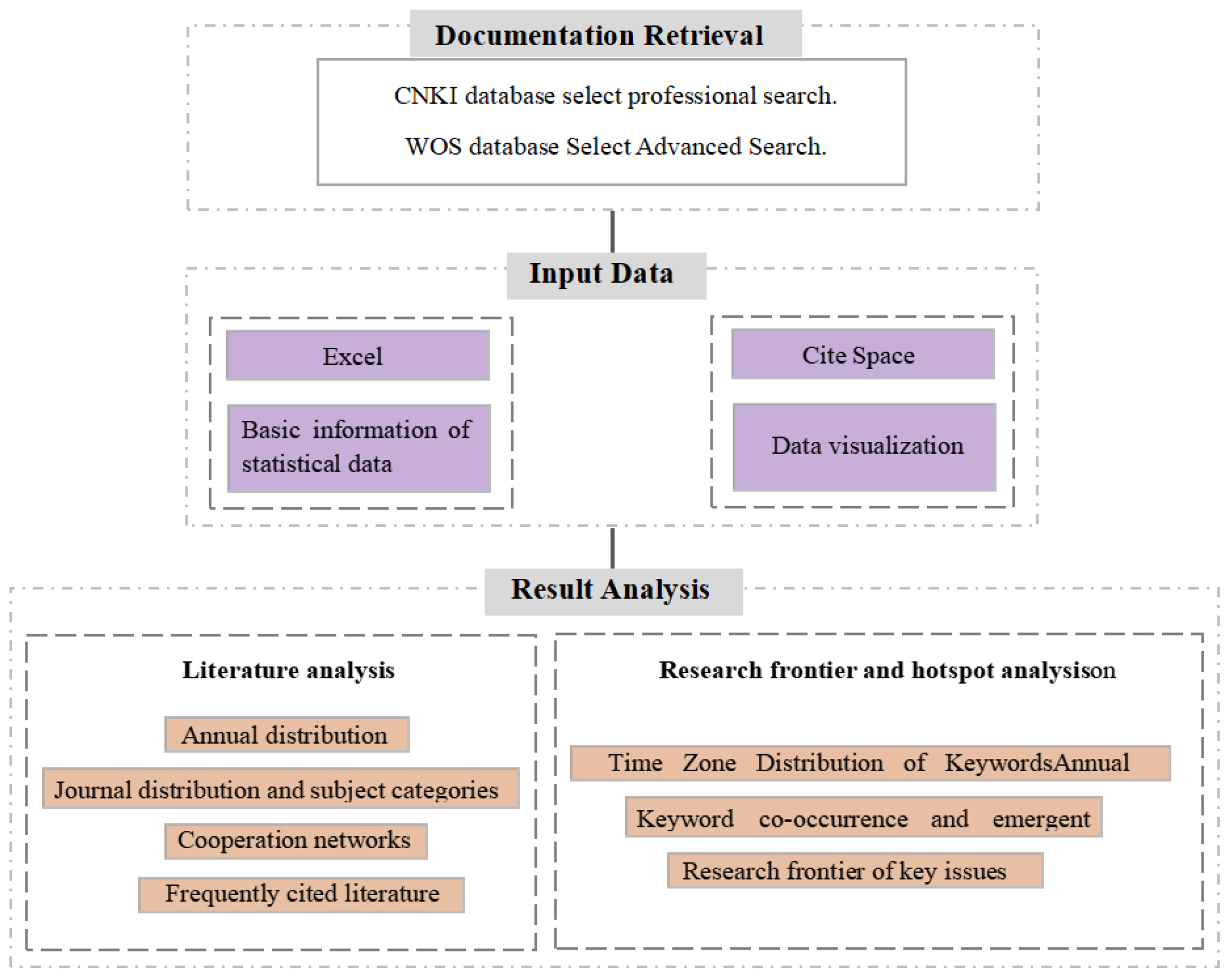
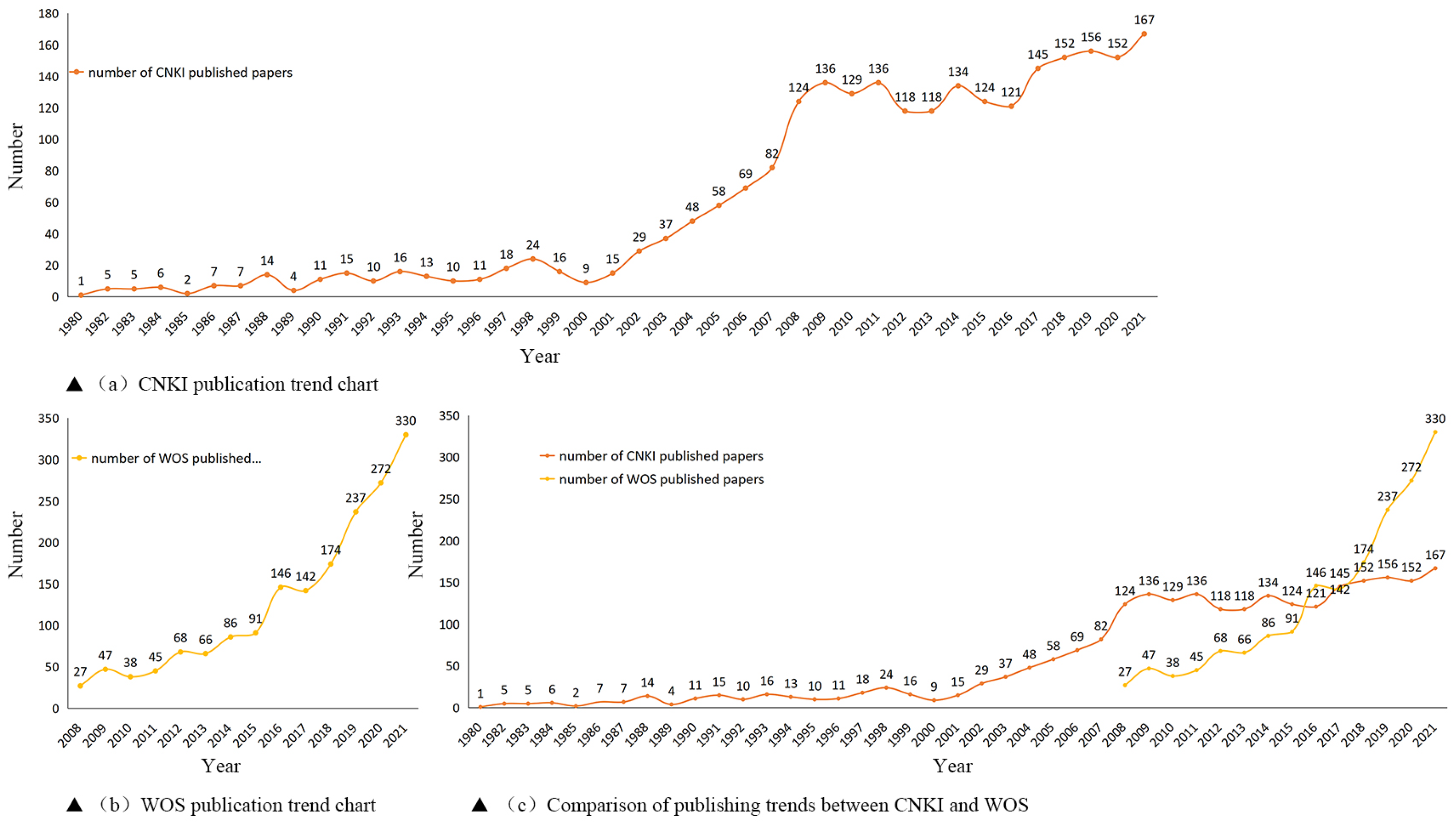
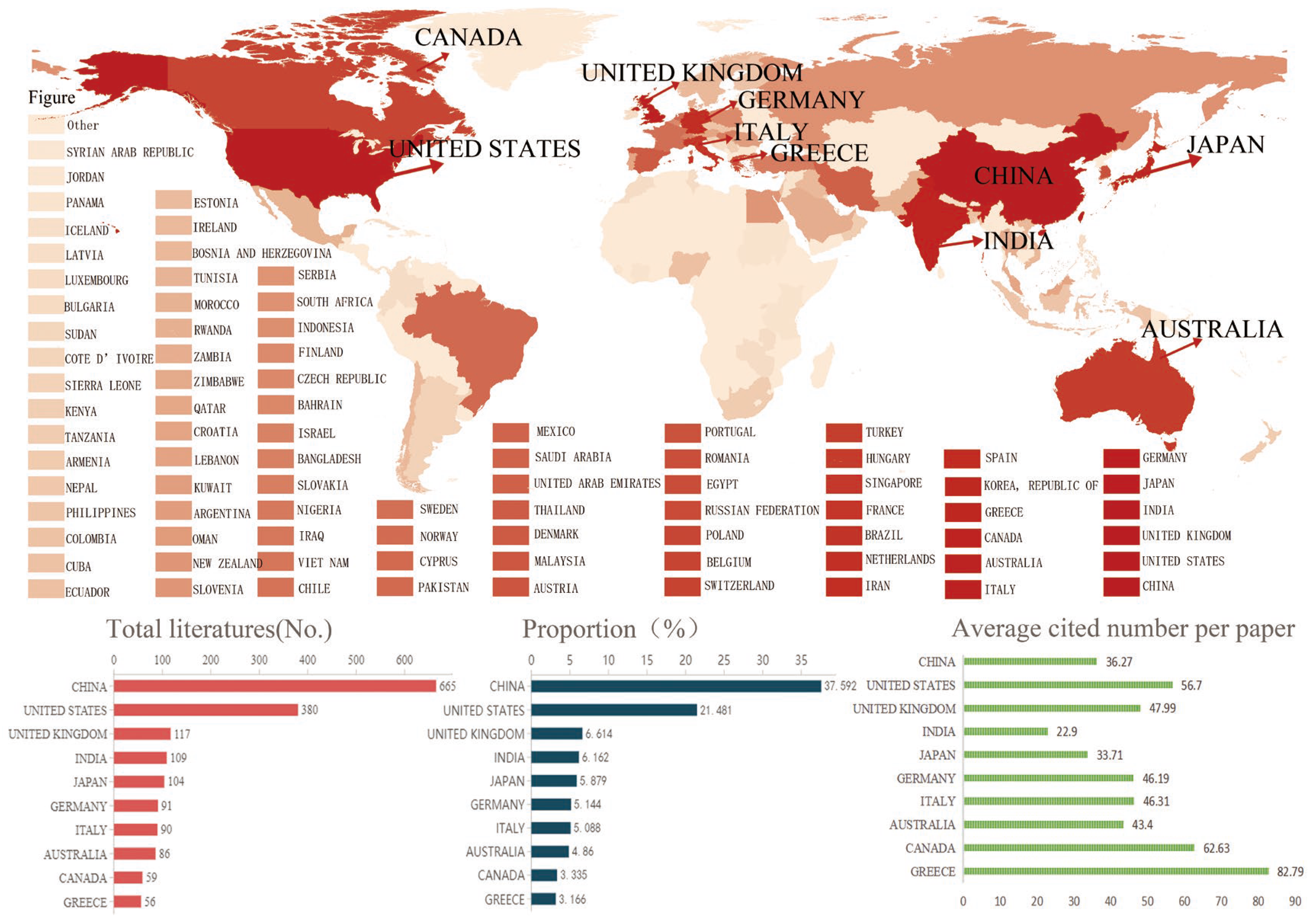
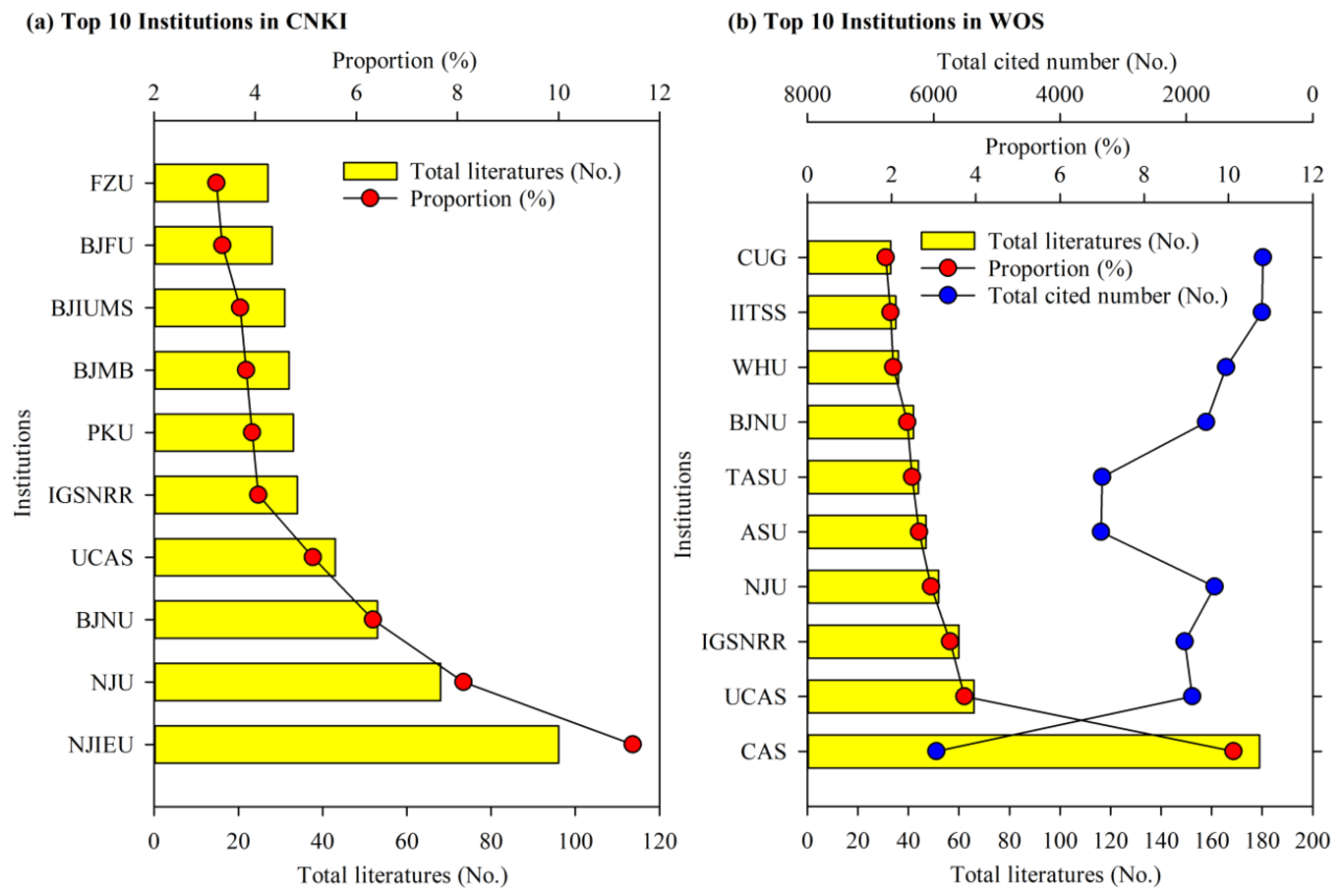
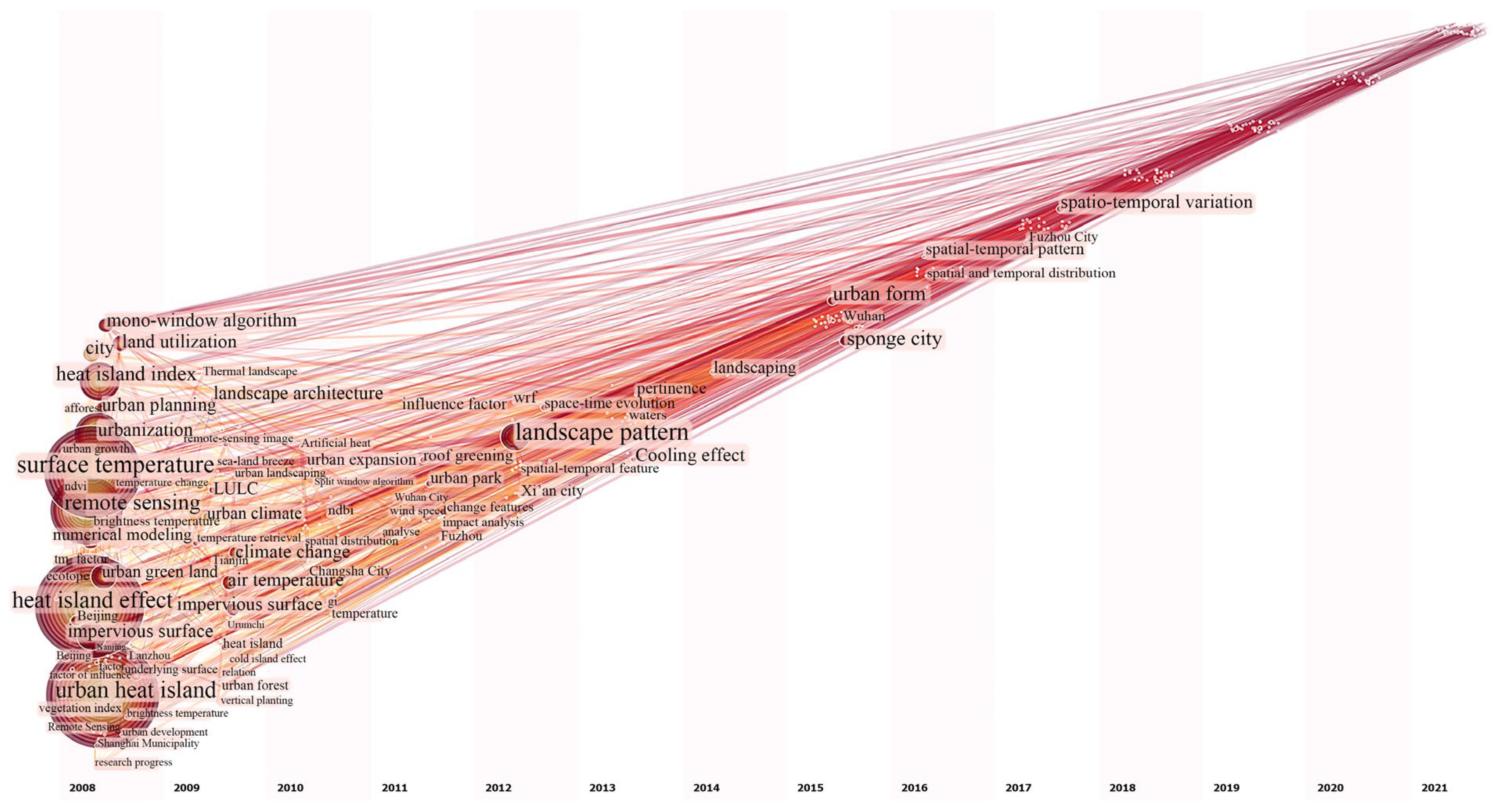
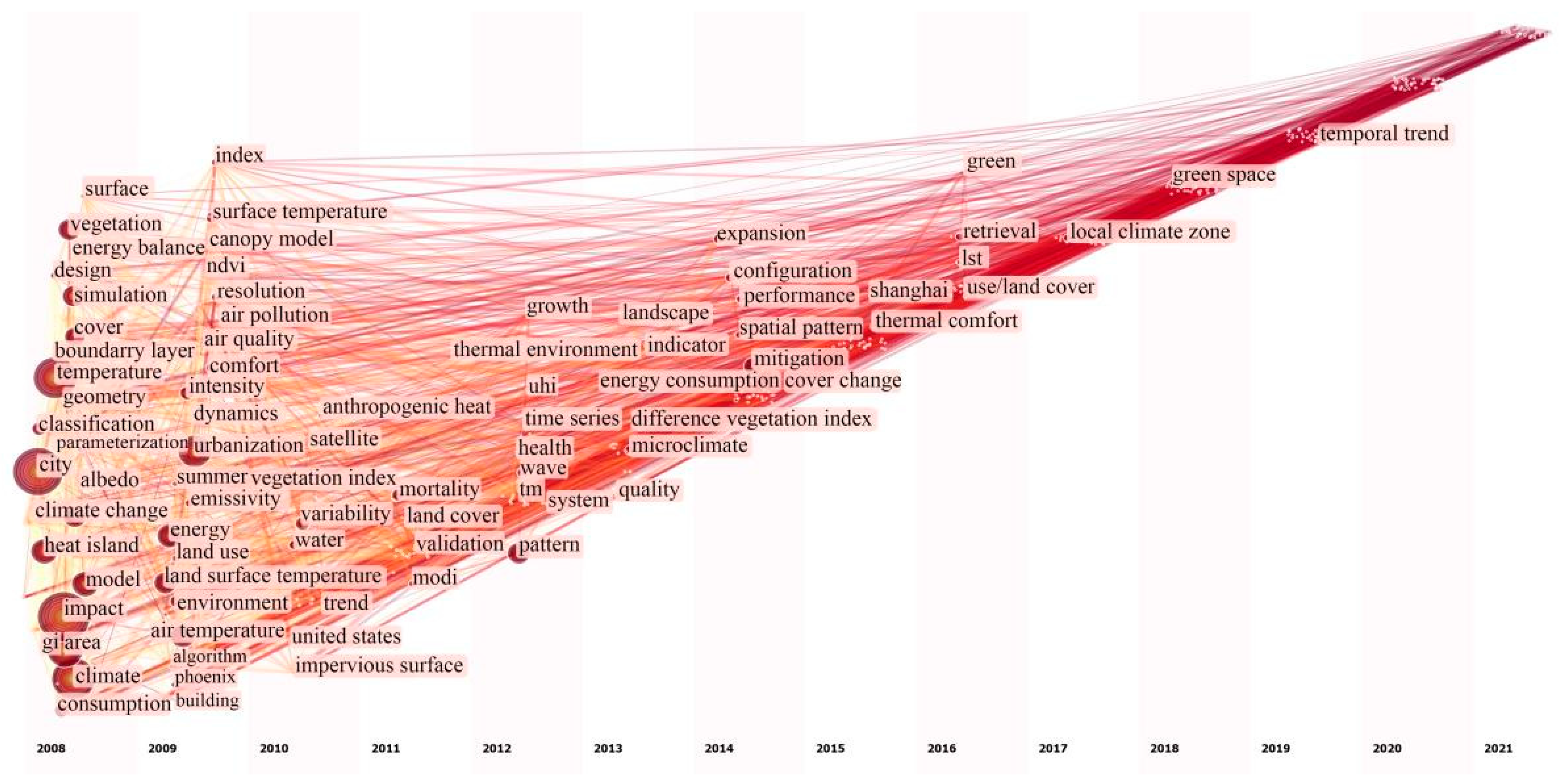

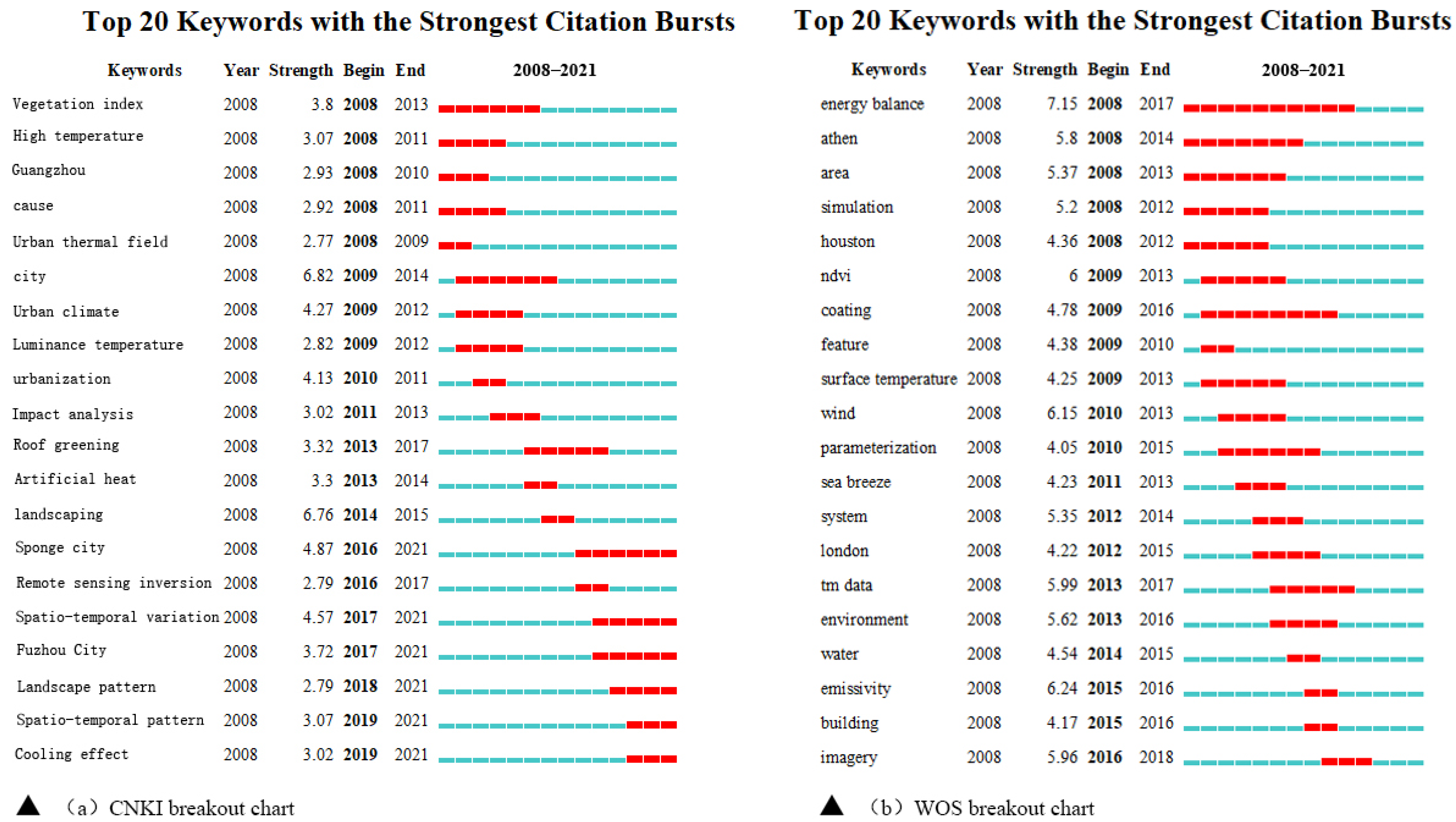
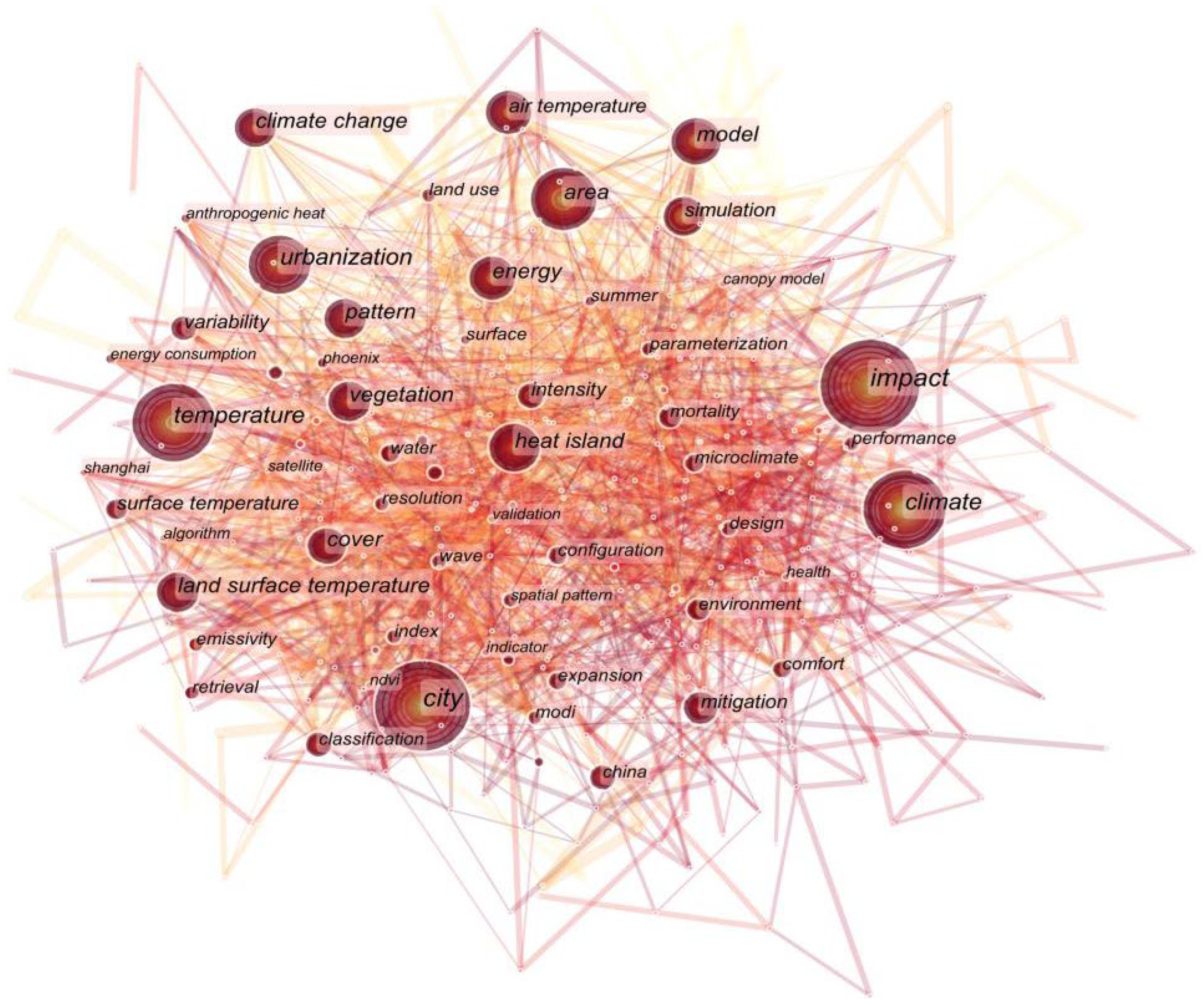
| No. | Journal | Total Articles | Proportion (%) | Journal Type | Compound Influence Factor | Comprehensive Impact Factor |
|---|---|---|---|---|---|---|
| 1 | Acta Ecologica Sinica | 56 | 11.27 | CSSCI | 4.733 | 3.444 |
| 2 | Ecology and Environmental Sciences | 47 | 9.46 | CSSCI | 2.667 | 2.002 |
| 3 | Remote Sensing Technology and Application | 33 | 6.64 | CSSCI | 2.105 | 1.535 |
| 4 | Chinese Journal of Ecology | 27 | 5.43 | CSSCI | 2.997 | 2.182 |
| 5 | Journal of Geo-information Science | 27 | 5.43 | CSSCI | 3.455 | 2.428 |
| 6 | Journal of Anhui Agricultural Sciences | 27 | 5.43 | CA\JST | 0.716 | 0.494 |
| 7 | Geomatics & Spatial Information Technology | 24 | 4.83 | JST | 0.81 | 0.576 |
| 8 | Resources and Environment in the Yangtze Basin | 23 | 4.63 | CSSCI | 4.145 | 3.009 |
| 9 | Scientia Geographica Sinica | 21 | 4.23 | CSSCI | 5.987 | 4.293 |
| 10 | Chinese Journal of Applied Ecology | 21 | 4.23 | CSSCI | 3.893 | 2.851 |
| Number | Journal | Total Articles | Proportion (%) | Journal Impact Factor | Average Number of Citations of Journal Papers per Year |
|---|---|---|---|---|---|
| 1 | Sustainable Cities and Society | 129 | 7.292 | 10.696 | 349.29 |
| 2 | Remote Sensing | 103 | 5.822 | 13.85 | 196.93 |
| 3 | Urban Climate | 96 | 5.427 | 6.663 | 122.79 |
| 4 | Sustainability | 81 | 4.579 | 3.889 | 91.07 |
| 5 | Building and environment | 73 | 4.127 | 7.093 | 251.00 |
| 6 | Science of the total Environment | 71 | 4.014 | 10.753 | 310.71 |
| 7 | Theoretical and applied climatology | 58 | 3.279 | 3.409 | 133.5 |
| 8 | Energy and buildings | 45 | 2.544 | 7.201 | 219.79 |
| 9 | Journal of Applied Meteorology and Climatology | 43 | 2.431 | 3.557 | 161.71 |
| 10 | International journal of Remote Sensing | 31 | 1.752 | 3.531 | 67.93 |
| No. | Author | Year | Title | Journal | Total Citation Frequency |
|---|---|---|---|---|---|
| 1 | Chen Liding [26] | 2013 | Eco-environmental effects of urban landscape pattern changes: progresses, problems, and perspectives | Acta Ecologica Sinica | 414 |
| 2 | Xu Hanqiu [27] | 2013 | A remote sensing urban ecological index and its application | Acta Ecologica Sinica | 371 |
| 3 | Shou Yixuan [38] | 2012 | Recent advances in understanding urban heat island effects with some future prospects | Journal of Meteorology | 261 |
| 4 | Xu Hanqiu [28] | 2009 | Quantitative analysis on the relationship of urban impervious surface with other components of the urban ecosystem | Acta Ecologica Sinica | 241 |
| 5 | Bai Yang [39] | 2013 | Progress of urban heat island effect | Journal of Meteorology and Environment | 240 |
| 6 | Peng Baofa [30] | 2013 | The impacting mechanism and laws of function of urban heat islands’ effect: A case study of Shanghai | Acta Geographica Sinica | 230 |
| 7 | Chen Songlin [33] | 2009 | Comparison Analyses of Equal Interval Method and Mean-standard Deviation Method Used to Delimitate Urban Heat Islands | Journal of Geoinformation Science | 206 |
| 8 | Xu Hanqiu [29] | 2011 | Analysis on urban heat island effects based on the dynamics of urban surface biophysical descriptors | Acta Ecologica Sinica | 182 |
| 9 | Su Yongxian [31] | 2010 | The cooling effect of Guangzhou City parks to surrounding environments | Acta Ecologica Sinica | 173 |
| 10 | Sun Jisong [32] | 2008 | Meso-β Scale Torrential Rain Affected by Topography and the Urban Circulation | Atmospheric sciences | 155 |
| No. | Author | Year | Title | Journal | Total Citation Frequency |
|---|---|---|---|---|---|
| 1 | Santamouris, M [37] | 2014 | Cooling the cities–A review of reflective and green roof mitigation technologies to fight heat islands and improve comfort in urban environments | Solar Energy | 858 |
| 2 | Imhoff, ML [34] | 2010 | Remote sensing of the urban heat island effect across biomes in the continental USA | Remote Sensing of Environment | 777 |
| 3 | Li, JX [35] | 2011 | Impacts of landscape structure on surface urban heat islands: A case study of Shanghai, China | Remote Sensing of Environment | 600 |
| 4 | Peng, SS [40] | 2012 | Surface Urban Heat Island Across 419 Global Big Cities | Environmental Science & Technology | 590 |
| 5 | Zhao, L [36] | 2014 | Strong contributions of local background climate to urban heat islands | Nature | 574 |
| 6 | Tan, JG [41] | 2010 | The urban heat island and its impact on heat waves and human health in Shanghai | International Journal of Biometeorology | 558 |
| 7 | Santamouris, M [42] | 2011 | Using advanced cool materials in the urban built environment to mitigate heat islands and improve thermal comfort conditions | Solar Energy | 536 |
| 8 | Zhou, WQ [43] | 2011 | Does spatial configuration matter? Understanding the effects of land cover pattern on land surface temperature in urban landscapes | Landscape and Urban Planning | 510 |
| 9 | Buyantuyev, A [44] | 2010 | Urban heat islands and landscape heterogeneity: linking spatiotemporal variations in surface temperatures to land-cover and socioeconomic patterns | Landscape Ecology | 456 |
| 10 | Estoque, RC [45] | 2017 | Effects of landscape composition and pattern on land surface temperature: An urban heat island study in the megacities of Southeast Asia | Science of the total Environment | 436 |
Disclaimer/Publisher’s Note: The statements, opinions and data contained in all publications are solely those of the individual author(s) and contributor(s) and not of MDPI and/or the editor(s). MDPI and/or the editor(s) disclaim responsibility for any injury to people or property resulting from any ideas, methods, instructions or products referred to in the content. |
© 2023 by the authors. Licensee MDPI, Basel, Switzerland. This article is an open access article distributed under the terms and conditions of the Creative Commons Attribution (CC BY) license (https://creativecommons.org/licenses/by/4.0/).
Share and Cite
Liu, Y.; Wang, Z. Research Progress and Hotspot Analysis of Urban Heat Island Effects Based on Cite Space Analysis. Land 2023, 12, 1154. https://doi.org/10.3390/land12061154
Liu Y, Wang Z. Research Progress and Hotspot Analysis of Urban Heat Island Effects Based on Cite Space Analysis. Land. 2023; 12(6):1154. https://doi.org/10.3390/land12061154
Chicago/Turabian StyleLiu, Yan, and Zhijie Wang. 2023. "Research Progress and Hotspot Analysis of Urban Heat Island Effects Based on Cite Space Analysis" Land 12, no. 6: 1154. https://doi.org/10.3390/land12061154
APA StyleLiu, Y., & Wang, Z. (2023). Research Progress and Hotspot Analysis of Urban Heat Island Effects Based on Cite Space Analysis. Land, 12(6), 1154. https://doi.org/10.3390/land12061154






